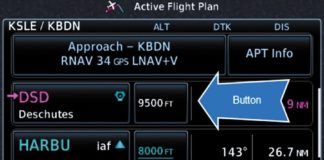How High Is Safe, Legal?
The last question on October’s Killer Quiz asks at what altitude you must leave the MPV VOR. You’ve departed on the ODP, which says to cross MPV at or above 3500 feet before proceeding on course. But, the scenario is that you’re entering an ILS 17 feeder route from MPV, and that altitude is 5900 to the IAF at TJAYS. You said it’s required to cross MPV at 5900 (answer c). I disagree. The ODP contains no course restrictions with that altitude. An aircraft may proceed direct anywhere after it has crossed the VOR at or above 3500 feet and should continue to climb as required. The correct answer (d) is to cross MPV at or above 3500 feet as specified by the ODP, and continue climbing to 5900 per the feeder route on the ILS. After all, if I weren’t flying the ILS, but simply filed MPV TJAYS and on, that’s what I’d do.
Daniel Herr
Murray Hill, NJ
This question has caused quite a discussion here in the IFR virtual offices. We’ve come to an agreement and we’ll stick with our original answer, but with a lot more explanation.
This is one of those cases where legal and safe are two different things. It’s also a case of a procedure not being able to accommodate all possible use cases. Approach procedures are designed assuming that you’re descending from the enroute structure. Thus, the 5900-foot restriction makes perfect sense.
Except in this case, you’re coming from an ODP, something not anticipated in the approach design. Yes, you are perfectly legal and safe crossing MPV per the ODP at 3500 feet and continuing a climb on course. Agreed.
But, you’re now flying a segment of a published approach. That segment does not allow for a climb to the minimum altitude of 5900. So, to be strictly (and, we agree, overly) legal, you must now cross MPV at or above 5900 feet, simply by virtue of the chart you’re using. We agree you’d be safe climbing on the feeder from 3500 over MPV, and we believe that you could make a strong argument for that if ever questioned. Recall also that you’re flying this approach only after having exercised your emergency authority, giving you more room to argue safety of the procedure.
We should point out, though, that the missed approach procedure requires 5200 feet at MPV, not the 3500 the ODP specifies over the same route. Clearly there is some obstruction concern by the procedure designers, reinforcing the original answer.
Can’t Get There From Here
It’s been awhile since I’ve flown around New York. Things have changed. Clearly, I’ve been paying insufficient attention to the disappearance of the LHY VOR and the emergence of Tango routes.
It seems that a new fix, LAAYK, fills the same function as LHY previously, but with more options. The FAA seems to prefer this rather northerly (and lengthy) routing around New York’s Class B to more direct alternatives. Yesterday, I was flying from Wilmington, DE to Hyannis, MA and filed via FJC and V162 to HUO at 5000 feet as I have many times in the past. I was initially cleared as filed, but Clearance called back while I was still on the ground and read me an amended clearance through LAAYK, after Allentown.
I departed with that clearance, reckoning that I could negotiate after Philadelphia handed me off. Sure enough, I got direct SCOUP as I hoped. So far, so good but a less familiar pilot may not have known of this alternative. I have no idea why my original filing and clearance was voided. Any thoughts from IFR?
John Ward
Brewster, MA
We asked Tarrance Kramer, our resident controller, to take a look and he responded:
I’ve looked at these routes. It’s about 310-340 miles, but the departure airport’s only 100 miles from the New York City complex. At that distance, Philadelphia Approach—which sits on top of your departure airport—is likely subject to letters of agreement with New York Center and/or TRACON. In this case, these letters would set standard routes that must be given to traffic traversing and entering that busy airspace.
I believe the reroute has to do with your equipment suffix. If an aircraft is RNAV-capable, they get LAAYK. If not, they get a preferred IFR route. I learned this in a letter from an FAA manager covering the decommissioning of LHY and the establishment of LAAYK, its T-routes and preferred IFR routes, that’s on the Teterboro Users Group web site.
The clearance delivery controller may have taken a look at the pilot’s suffix after the initial “as filed” clearance and realized he needed to clear him via LAAYK. Without more information, I’m just taking an educated guess at this point. As far as negotiating in the air, tower guys usually don’t have much view of the surrounding airspace, so their hands are tied by their smaller picture. The radar guys at Philadelphia and New York TRACONs do know what’s going on down the way, so they can wheel and deal with the other radar facilities. That said, the negotiating may have worked that time, but there are never any guarantees. New York is an incredibly busy airspace and sometimes they just won’t let the low-level traffic through. Anyway, these are my best guesses. Every facility is so different from every other facility, it’s hard to reach a definitive conclusion without all the agreements and other information.
OK, So Who Is First
I enjoyed reading “Who’s on First” by Tarrance Kramer in the November 2014 issue. And I can appreciate the little suspenseful device of putting the question to the readers. But leaving us readers hanging for the “who’s number one” is killing me. So who really is number one?
Al Noble
(No location provided.)
Sorry, Al. That one is truly a judgment call. There’s no clear answer and different controllers might make different decisions. Thanks for playing, though.
Now, having put that out there, we did ask Tarrance what he’d do, and he responded:
I’d probably launch the guy who’d waited because 1) he’d waited, 2) he was using the active runway, and 3) the other guy wanted something special. But, I could also try to expedite things for the new guy by asking the first for an early turn. We do what we can.
We read ‘em all and try to answer most e-mail, but it can take a month or more. Please be sure to include your full name and location. Contact us at [email protected].




